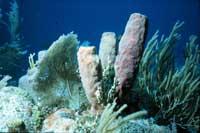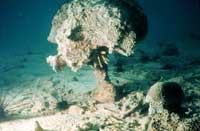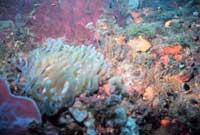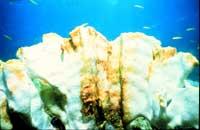Corals: marine treasures
The 9,800 square kilometers that make up the sanctuary include the islands of Florida, Florida Bay, the Gulf of Mexico and the Atlantic Ocean. Coral barriers grow in waters near dry land masses and require very precise physical conditions for their development. Normally, the areas between the tropics of Capricorn and Cancer are the place of residence of the coral reefs, because the tropical waters are warm, clear, with low levels of nutrients, nitrogen and phosphorus, with stable temperatures and salinity. However, ocean currents can alter the physical state of an area and expand or reduce reef development regions. In Florida, for example, the coral reef grows farther north than it would be from the hot waters of the Gulf Stream.

The Gulf Stream carries warm tropical waters from the South Atlantic, the Caribbean Sea and the Gulf of Mexico to the Florida Barrier Reef to the north. These warm waters have allowed the growth of the coral barrier to the north and thanks to these warm waters, the fish and seafood of the tropical areas inhabit Florida, although it is not a tropical geographic region.
Reefs are underwater cities built over thousands of years with calcium carbonate and, of course, formed by communities of organisms that produce calcium carbonate. Calcium carbonate is produced by many plants and marine animals, as well as some species of seaweed and marine invertebrates. Calcium carbonate is the skeleton of these beings, which can be an internal skeleton similar to the human skeleton or an external skeleton similar to snails. In both cases, calcareous skeletons form rigid structures that support waves: reefs. And when the main component of reefs are corals and some species of algae, reefs are called coral reefs.
The base or living tissue of the reefs are the polypopes, corals in the form of small anemones, which accompany, or rather inside, small beings capable of photosynthesis and transforming the energy of the Sun into nutrients: the monocellular algae called zooxanthellae. These green or yellow algae give color to corals. But in addition to color, zooxanthellae have two main functions: although corals are carnivorous - they feed on zooplankton -, most of the oxygen and energy they need to live collect it as a side product of the photosynthesis of these algae. On the other hand, zooxanthellae create an alkaline medium necessary so that the new calcium carbonate produced by corals can join the basic structure.

... The relationship between corals and algae is symbiotic, that is, algae are beneficial for corals and vice versa. Algae allow the life and growth of corals and the growth of corals allows to increase the residence of algae. In fact, symbiotic relationships between organisms are very common in choral barriers.
The addition of calcium carbonate to the basic structure makes the coral skeleton increase and this larger skeleton becomes a residence for new living beings that generate more calcium carbonates. In adequate conditions and with sufficient time, some coral structures may become larger than the adult person. Some do not reach an annual centimeter of growth speed, others can increase up to 10 centimeters in a year. The latter are often more fragile.
Coral barriers are more than buildings of organisms with calcareous skeleton. The biodiversity of the reefs is supported by extensive herb meadows and spider webs of mangrove trees. The so-called marine herbs are not algae, but plants with real roots, stems and leaves. According to the researchers, marine herbs, descendants of terrestrial plants adapted to the underwater conditions, play an important role in benefit of the coral barrier: they produce the essential oxygen for life; the leaves and roots capture sediments and particles and store the water transparently; the sutrayos and the horizontal stems they contain protect the seabeds from the erosion of the waves. And the mangroves the same.
Mangroves are coastal trees that grow in tropical areas, although they are sometimes found inside the sea, with their roots under water and their cup over water. Trees are able to transform salt water into fresh water, allowing them to live in saline media. Some remove excess salt through leaves and others have roots that prevent salt absorption. Mangroves, like marine herbs, capture sediments and store water transparently, but also participate in biological cycles of different foods. Marine herbs and mangroves are home to coral barrier fauna, a source of protection and food for many animals that inhabit fish, seafood and reefs. Without these plants there would be no reef fauna: sheltered from the roots, the small larvae become fish and the coastal birds nest in the branches that are seen on the water.

Coral reefs are complex and fragile ecosystems, made up of highly interdependent living beings, with a higher degree of biodiversity than any other marine environment: Of the 23 animal films on Earth, 22 are found on Earth. More than 100 coral species, hundreds of fish species and eleven sponges, sea urchins and worms. Shellfish also abound in coral reefs, such as lobster.
However, Florida's maritime sanctuary goes down. In recent years, reef diseases have increased, coral whitening and the layer of live corals has decreased, algae have increased to invasive and the population of some species of fish has decreased considerably. All of them reflect the unhealthy reefs. The bleaching of the corals is a "natural" phenomenon that in recent years has become very worrying: when the temperatures of the waters are excessively high, the algae zooxanthellae escape from the corals and the pigment of the corals are these, so the breathless corals remain white. The problem is not losing color. Without laughter, the most important food source of corals disappears and if bleaching persists too long, the corals will die. Although marine waters have natural temperature cycles, coral bleaching has become a very worrying problem: in the last 20 years there have been 6 massive periods of bleaching, while in 1998 many corals of the world died.

Another worrying phenomenon is the excessive reproduction of algae. In addition to Zooxanthellae, we can find in the reefs algae species that live outside the corals. These algae feed on the nutrients provided by marine currents and when there are many nutrients they multiply quickly. Although to the extent necessary, they can cover corals and marine herbs when there are too many algae, closing access to solar rays. Without sun there is no photosynthesis or photosynthesis. Some species of algae can produce coral diseases.
Whiten corals, kill fish, seafood and marine herbs and proliferate algae. Corals have suffered great damage in recent years and the most pessimistic forecasts point to the disappearance of coral barriers by 2070. The greenhouse effect is the basis for many of these problems, as management did not need sewage from coastal and island dwellers. But also extra-human agents can be the cause of coral decline.
Conditions necessary for the development of corals:
- Surfaces with high light radiation: 2000 uE/m2 /s
- Oxygen abundance: 5.0-7.0 mg/l
- Low turbidity level: 0.01-0.10 mg/l
- Low nutrients: 0.01-0.1 uM
- Stable temperatures: 18-30 °C
- Stable levels of salinity: 33-36%
Corals and piratesThe Florida Sea Sanctuary also protects treasures of less natural origin than colorful plants and fish. In times when North and South America were the European colony, from America to Europe and from Europe to America, many ships passed through Florida. Some of them are buried. Tropical storms, abundant in Florida and the Caribbean, were responsible for many sinking, but the coral barrier was not left behind. The first complete map indicating the location of the reefs was published in 1825 and without a map it was difficult to detect shallow waters remotely. Because of it, or because of it, the waters of Florida are more abundant than anywhere else. Colonial containers of the twentieth century. Wars and sea wars have also left their mark on the Florida seabed: Shipwrecks ranging from wars between Indian tribes Seminola to World War II. There are currently more than 400 archaeological sites being studied on the Florida seabed, but there are many more to be discovered. These spaces are the refuge of instruments, etc., heritage of history, but also the yearning of many treasure hunters who dream of lost gold and precious stones. |
Published in the supplement Natura de Gara
Buletina
Bidali zure helbide elektronikoa eta jaso asteroko buletina zure sarrera-ontzian











